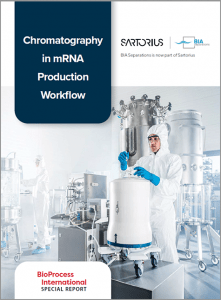 Rapid response to global pandemics requires the manufacture of billions of vaccine doses within months. This short timeline must allow for design and testing of active ingredients, development of production and purification processes, clinical evaluations, regulatory filings, and manufacturing. Existing purification methods often have been adopted from laboratory-scale techniques to allow rapid implementation, and those have provided adequate product quality. But future mRNA development will require optimized production and purification processes.
Rapid response to global pandemics requires the manufacture of billions of vaccine doses within months. This short timeline must allow for design and testing of active ingredients, development of production and purification processes, clinical evaluations, regulatory filings, and manufacturing. Existing purification methods often have been adopted from laboratory-scale techniques to allow rapid implementation, and those have provided adequate product quality. But future mRNA development will require optimized production and purification processes.
Chromatography has been a workhorse of biomanufacturing for decades, including for monoclonal antibodies, plasmid DNA, viruses, and other modalities — as well as for supporting analytics. As an emerging therapeutic modality, mRNA production requires the development of new methodologies to suit its peculiar physicochemical profile: large, charged, and relatively unstable. Due to requirements for high purity, these methodologies will be based in large part on chromatography.
This article describes the versatility of chromatography when applied to mRNA production, starting with the purification of the key raw material (plasmid DNA) to final polishing of mRNA drug substance. Utilizing multiple attributes of mRNA (charge, hydrophobicity, size, polyadenylation), various tools can be developed at preparative or analytical scale for selective capture (by affinity or charge), removal of key contaminants (e.g. dsRNA), or determination of critical quality attributes (capping efficiency). Monitoring of in vitro transcription (IVT) reaction kinetics by rapid high-performance liquid chromatography (HPLC) methodologies is presented as a unique solution offered by convective interaction media (CIM) monoliths, chromatographic media that are ideally suited to tackling biomanufacturing and analytical challenges of mRNA production.
Fill out the form below to read the special report now.
